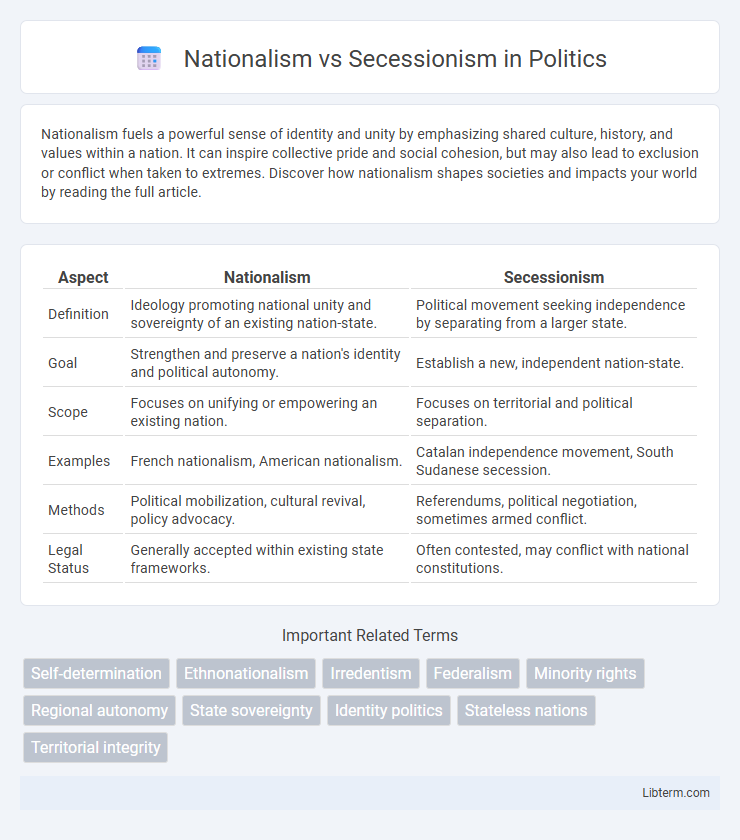Nationalism fuels a powerful sense of identity and unity by emphasizing shared culture, history, and values within a nation. It can inspire collective pride and social cohesion, but may also lead to exclusion or conflict when taken to extremes. Discover how nationalism shapes societies and impacts your world by reading the full article.
Table of Comparison
| Aspect | Nationalism | Secessionism |
|---|---|---|
| Definition | Ideology promoting national unity and sovereignty of an existing nation-state. | Political movement seeking independence by separating from a larger state. |
| Goal | Strengthen and preserve a nation's identity and political autonomy. | Establish a new, independent nation-state. |
| Scope | Focuses on unifying or empowering an existing nation. | Focuses on territorial and political separation. |
| Examples | French nationalism, American nationalism. | Catalan independence movement, South Sudanese secession. |
| Methods | Political mobilization, cultural revival, policy advocacy. | Referendums, political negotiation, sometimes armed conflict. |
| Legal Status | Generally accepted within existing state frameworks. | Often contested, may conflict with national constitutions. |
Understanding Nationalism: Core Concepts and History
Nationalism centers on the collective identity and unity of a population based on shared culture, language, and history, emphasizing sovereignty and self-determination within established nation-states. Historically, nationalism emerged during the 18th and 19th centuries, significantly shaping political revolutions and the formation of modern states in Europe through movements like the French and German unifications. Core concepts include patriotism, national pride, and the pursuit of political autonomy, distinguishing it from secessionism, which specifically advocates for the formal withdrawal of a territory from an existing state.
Defining Secessionism: Origins and Evolution
Secessionism originates from the desire of a distinct political or cultural group to break away from an existing state, driven by aspirations for self-determination and autonomy. Historically, secessionist movements have evolved through various phases, influenced by colonial legacies, ethnic identities, and economic disparities, shaping their ideological and tactical approaches. The evolution of secessionism reflects complex interactions between national identity, state sovereignty, and international law, highlighting the tension between unity and fragmentation within modern states.
Nationalism vs. Secessionism: Key Differences
Nationalism emphasizes the promotion of a unified national identity and loyalty to a sovereign state, while secessionism advocates for the political separation of a region or group from an existing state to form an independent entity. Nationalism often seeks to strengthen national cohesion and sovereignty, whereas secessionism challenges existing borders, driven by cultural, ethnic, or political distinctions. The key difference lies in nationalism's focus on unity within a state versus secessionism's pursuit of autonomy and self-determination through separation.
Motivations Behind Nationalist Movements
Nationalist movements are primarily driven by a shared sense of cultural identity, historical grievances, and the desire for political self-determination among a population. These motivations often stem from perceived threats to language, traditions, or economic interests, fueling ambitions for autonomy or independence. Nationalism seeks to unify a group based on ethnicity or nationhood, whereas secessionism specifically aims at breaking away from a larger political entity to form a sovereign state.
The Driving Forces of Secessionist Movements
Secessionist movements are primarily driven by ethnic identity, economic disparities, and political marginalization, fueling desires for self-determination and autonomy. Grievances over cultural recognition and historical injustices intensify demands for independence from centralized state authority. Resource control and governance representation often exacerbate tensions, making national sovereignty a core issue in secessionist conflicts.
Case Studies: Successful and Failed Secessions
The case of South Sudan's successful secession in 2011 highlights the power of sustained international support and clear ethnic distinctions in achieving statehood, contrasting sharply with Catalonia's failed attempt driven by economic grievances and cultural nationalism hindered by Spain's constitutional rigidity. Kosovo's independence, recognized by over 100 UN members, demonstrates how international political backing and conflict aftermath contribute to successful secession, whereas the Chechen bid for independence faced violent suppression and limited recognition due to Russia's strategic interests. These case studies reveal that secession success largely depends on external recognition, internal unity, and geopolitical dynamics rather than purely nationalist aspirations.
The Role of Identity in Nationalism and Secessionism
Identity plays a central role in both nationalism and secessionism, as it shapes collective consciousness and the desire for political autonomy. Nationalism often emphasizes shared language, culture, and history to foster unity within existing state boundaries, while secessionism emerges when distinct identity groups seek independence to preserve their unique cultural or ethnic characteristics. The strength of identity-based claims significantly influences the legitimacy and intensity of secessionist movements across the globe.
Political, Economic, and Social Impacts
Nationalism often unites a population under a shared identity, fostering political cohesion and strengthening state sovereignty, while secessionism challenges existing borders, potentially leading to political instability and conflict. Economically, nationalism can promote domestic industries through protectionist policies, whereas secessionism risks disrupting trade networks and investment flows by creating economic uncertainty. Socially, nationalism reinforces collective identity and cultural pride, but secessionism may deepen divisions, provoke ethnic tensions, and result in social fragmentation.
International Law and the Right to Self-Determination
International law recognizes the principle of self-determination, allowing peoples to pursue political status and cultural identity, but its application often conflicts with the territorial integrity of sovereign states. Nationalism drives movements advocating for collective identity within existing borders, while secessionism demands formal separation, raising complex legal disputes in bodies like the United Nations and International Court of Justice. The tension between these forces highlights the challenge of balancing respect for state sovereignty with the rights of distinct populations seeking autonomy or independence.
Future Trends: Nationalism, Secessionism, and Global Stability
Future trends indicate that rising nationalism may fuel secessionist movements, challenging global stability by intensifying regional conflicts and political fragmentation. Advances in technology and social media are accelerating the spread of nationalistic and secessionist narratives, potentially undermining existing states and international cooperation frameworks. International organizations and governments must adapt policies to address these dynamics, promoting dialogue and inclusive governance to mitigate risks to global peace and security.
Nationalism Infographic

 libterm.com
libterm.com